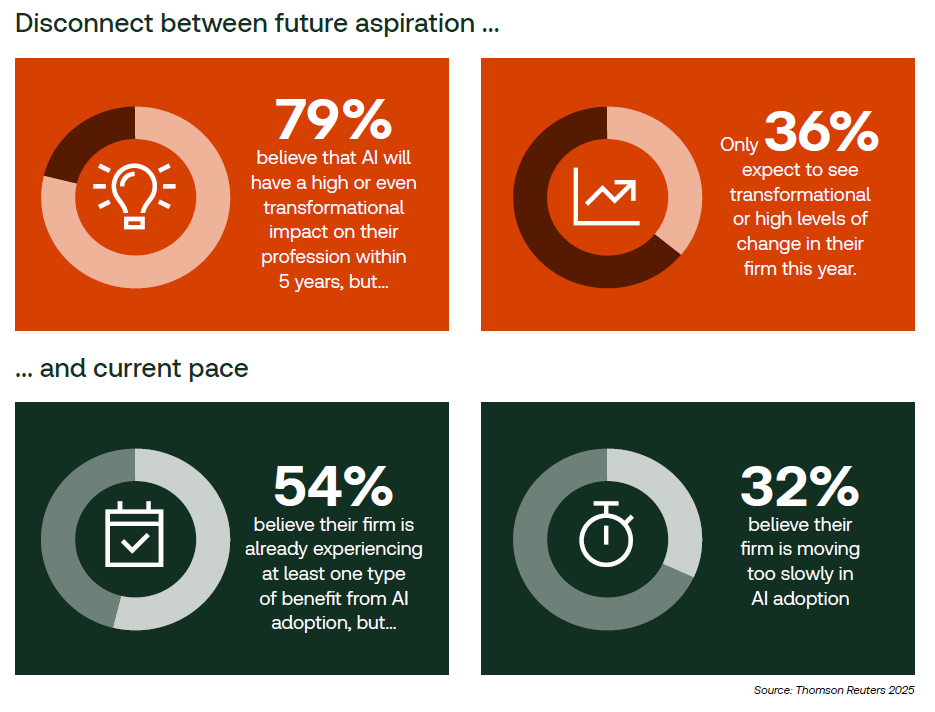A new report highlights the transformative impact of AI on professional services, emphasizing the widening competitive gap between organizations with AI strategies and those that are going ahead without one
Key Findings:
-
-
-
Transformative impact of AI — The report highlights the significant impact of AI on professional services, emphasizing many professionals are already experiencing increased efficiency, improved productivity, and reduced costs due to AI use.
-
Widening competitive gap — There is a growing competitive gap between organizations with formal AI strategies and those without. Organizations with visible AI strategies are twice as likely to experience revenue growth compared to those with informal or ad-hoc AI adoption approaches.
-
Need for strategic AI adoption — The report emphasizes the importance of adopting AI strategically, with a well thought out and communicated approach. Organizations that act with intention and purpose to leverage AI will lead, while those that wait will fall behind.
-
-
While there are many transformative developments unfolding around the world right now that are upending the status quo and shaking the very foundation of how many professional service industries operate, none may have a bigger impact on the future of professional services than the expected impact of AI.
Jump to ↓
Thomson Reuters Future of Professionals 2025
Over the last three years that Thomson Reuters has published its Future of Professionals report, we’ve seen AI and its progeny generative AI already well on their way to transforming the legal, risk, compliance, tax, accounting, and audit professions, along with global trade. In fact, today’s professionals already report increased efficiency, improved productivity, and reduced costs as the most significant benefits, making AI a crucial tool for organizations as they navigate a rapidly evolving set of business challenges.
In our latest iteration of the report, Future of Professionals 2025, we see that AI’s impact on professional work has only grown. And as the report makes clear, organizations must constantly consider how best to leverage the efficiency gains and other benefits offered by AI to maintain their competitive edge in today’s evolving business landscape.
The growing gap
As AI adoption reaches a pivotal stage for many organizations, it’s clear that a widening competitive gap is emerging, as the report illustrates. That gap — between those organizations that adopt an AI strategy and those that do not — is becoming a defining dynamic in today’s business environment.
Indeed, the report shows that those organizations with visible AI strategies are twice as likely to experience revenue growth as a direct or indirect result of AI adoption compared to those with more informal or ad-hoc AI adoption approaches. More worrisome, those organizations that haven’t developed and communicated an AI strategy are at risk of being left behind within a matter of years.
 For the AI adopters, this technological revolution will help them reinvent and automate entire business processes using AI, offer superior customer experiences, and ultimately lower their own costs. Based on the current predicted pace of AI adoption, legal professionals are expected to free up nearly 240 hours per year, up from 200 in 2024, unlocking an average annual value of $19,000 per professional. In the US, this could mean a $32 billion combined annual impact for the legal and tax & accounting sectors.
For the AI adopters, this technological revolution will help them reinvent and automate entire business processes using AI, offer superior customer experiences, and ultimately lower their own costs. Based on the current predicted pace of AI adoption, legal professionals are expected to free up nearly 240 hours per year, up from 200 in 2024, unlocking an average annual value of $19,000 per professional. In the US, this could mean a $32 billion combined annual impact for the legal and tax & accounting sectors.
As this value gap continues to widen, the organizations that seize a leading role in the AI adoption race will be the ones reaping these savings and providing greater value to their clients. Yet, the responsibility doesn’t stop there — it’s more personal than that, as the report shows. Those professionals who fail to develop their individual AI proficiency risk falling behind in critical skills and ending up on the wrong side of a competitive gap. Indeed, it’s becoming increasingly clear that while AI itself will not replace professionals, AI-enabled professionals certainly will.
Clearly, we’ve passed the stage of simply predicting AI’s impact — we’re now quantifying it. Organizations with clear, aligned strategies already are unlocking real return on investment by reclaiming time, cutting costs, and gaining ground. And professionals who are embracing AI are not just more productive; they’re increasing their own value as well.
More than anything, this year’s Future of Professionals report is establishing a dividing line: Those organizations that act with intention and purpose to leverage the needed tools to meet their challenges will lead; and those that wait will fall behind and ultimately will be unable to keep up at all.
The report demonstrates that the future isn’t just about simply adopting AI — it’s about doing so strategically, with an eye to building it into the very fabric of how your organization does its work.
You can download
a copy of Thomson Reuters Future of Professionals 2025 here







